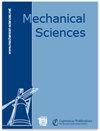空间网状口袋系统捕获姿态机动非协同目标的动态和滑模控制
IF 1.5
4区 工程技术
Q4 ENGINEERING, MECHANICAL
引用次数: 2
摘要
摘要与空间飞网类似,空间网状口袋系统的捕获场很大,可以灵活地应用于捕获空间非协同目标。为了保持空间网状袋系统的稳定性,使用了八个充气杆作为网状表面的支撑结构。本文对一个空间网状口袋系统进行了设计和建模。基于ANCF(绝对节点坐标公式),建立了复杂空间索网系统的动力学模型,并引入质量流单元,推导了考虑变长度的闭合索的精确模型。设计了一种双闭环滑动控制方法来保持服务航天器的稳定姿态。应用扩展观测器来估计和补偿系统中由于接触和柔性的不确定性而产生的扰动。最后,通过对虚拟样机的仿真验证了动态模型和控制方法。结果表明,该服务航天器在目标捕获过程中能够保持姿态稳定,在姿态机动过程中能够跟踪所需的角度。柔性变形和碰撞对服务航天器造成了很大的干扰,扩展观测器可以将控制精度从10−3提高到10−4。本文章由计算机程序翻译,如有差异,请以英文原文为准。
Dynamic and sliding mode control of space netted pocket system capturing and attitude maneuver non-cooperative target
Abstract. Similar to a space flying net, the capture field of the space
netted pocket system is large and it can be applied to capture space
non-cooperative targets flexibly. To maintain the stability of the space
netted pocket system, eight inflatable rods are used as the supporting
structure of the net surface. In this paper, a space netted pocket system is
designed and modeled. Based on ANCF (absolute nodal coordinate formulation),
a dynamic model of the complex space rope net system is established, and
then an accurate model of closing rope considering the variable length is
derived by introducing mass flow element. A double closed-loop sliding
control method is designed to maintain the stable attitude of the service
spacecraft. An extended observer is applied to estimate and compensate for
the disturbances due to the uncertainty of the contact and flexibility in
the system. Finally, the dynamic model and control method is verified
through the simulation of the virtual prototype. Results show that the
service spacecraft can maintain the attitude stability during target
captured process and can track the desired angle during attitude maneuver.
The flexible deformation and collision cause great disturbance to the
service spacecraft, and the extended observer can improve the control
accuracy from 10−3 to 10−4.
求助全文
通过发布文献求助,成功后即可免费获取论文全文。
去求助
来源期刊

Mechanical Sciences
ENGINEERING, MECHANICAL-
CiteScore
2.20
自引率
7.10%
发文量
74
审稿时长
29 weeks
期刊介绍:
The journal Mechanical Sciences (MS) is an international forum for the dissemination of original contributions in the field of theoretical and applied mechanics. Its main ambition is to provide a platform for young researchers to build up a portfolio of high-quality peer-reviewed journal articles. To this end we employ an open-access publication model with moderate page charges, aiming for fast publication and great citation opportunities. A large board of reputable editors makes this possible. The journal will also publish special issues dealing with the current state of the art and future research directions in mechanical sciences. While in-depth research articles are preferred, review articles and short communications will also be considered. We intend and believe to provide a means of publication which complements established journals in the field.
 求助内容:
求助内容: 应助结果提醒方式:
应助结果提醒方式:


